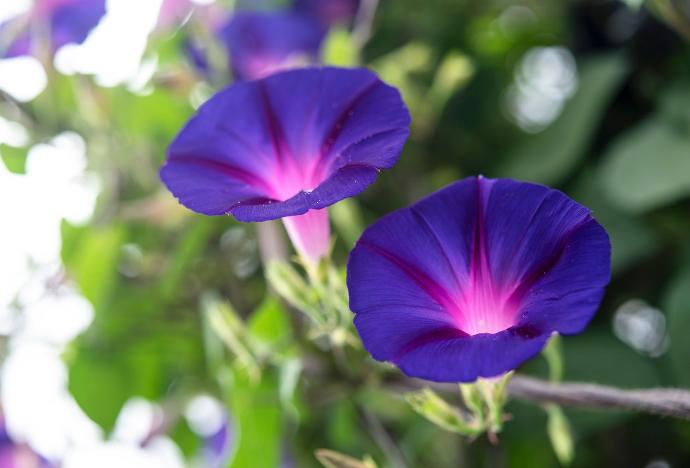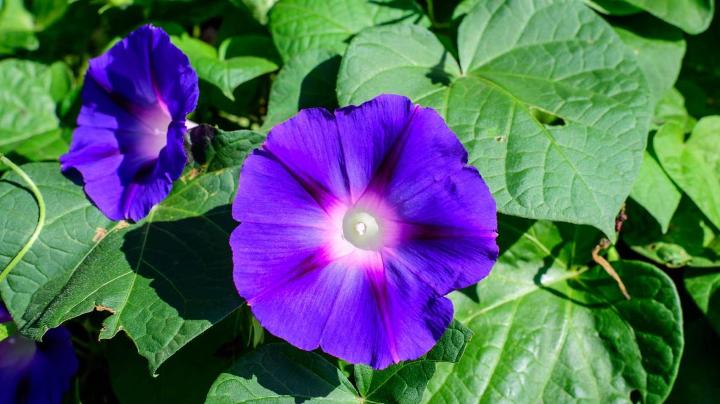Morning glory Plant
Morning Glory, also known as Ipomoea, is an outdoor climbing plant with colorful flowers. Plant in well-draining soil with full sun exposure. Provide support for climbing. Water consistently, and fertilize during the growing season. Pruning helps control its growth.

Habit
Climber
Height
2-3 meters
Growth
Fast
Soil
Well-drained, loamy soil
Shade
Full Sun
Moisture
Moist
Edible
No
Medicinal
No
Origin
North America
Climatic Condition
Warm, temperate
Temperature (°)
15-30
Humidity (%)
50-70
Potting media
Loamy or sandy soil
Fertilizers
Nitrogen-rich
Watering
High
Plant Weight
200-300 grams
Flowering Time
Spring to Fall
Soil Ph level
6.0-7.5
Water Ph level
6.0-6.5
Soil EC
0.3-0.4 mS/cm
Yield Per Plant
Moderate
NPK ratio
10:10:10
life Span
1-2 years
Health Benefits
Used in ornamental gardening, supports mental well-being, boosts mood
Suggested Grow Media or Potting Mix ?
50% compost, 30% perlite, 20% peat moss
Suggested Fertigation/Fertilizers
Fertilize every 2 weeks with a balanced, water-soluble fertilizer.
Common Diseases and Remedies
Fusarium rot, Stem rot.
Yellowing along the margin of the oldest leaves, A dark tan rot extends into the root.
Baking soda.
HEALTH BENEFITS
- Traditionally used for medicinal purposes, including as a laxative.
- Some species have antioxidant properties.
- Adds beauty to gardens, promoting relaxation and happiness.
What Is An Morning Glory Plant?
Morning Glory (Ipomoea) is a genus of flowering plants in the Convolvulaceae family, known for its bright trumpet-shaped flowers that usually bloom in the morning. These plants are often grown as ornamentals because of their attractive flowers and foliage. However, some morning glory species can become invasive in certain areas. Depending on the species, it is an annual or perennial vine that comes in a variety of colors, including purple, blue, pink, and white. Morning glory plants prefer full sun and well-drained soil.

What Are The Different Types Of Morning Glory Plants?
1. Ipomoea tricolor (Heavenly Blue):
Known for its large, bright blue flowers with white throats
2. Ipomoea purpurea (Grandpa Ot's):
Dark purple flowers with a red star-shaped pattern in the middle.
3. Ipomoea nil (Morning Glory):
This species has a wide range of cultivars with flowers of different colors and patterns and often has a more compact habit compared to other morning glories.
4. Ipomoea quamoclit (cypress vine):
Known for its delicate fern-like leaves and small scarlet tubular flowers.
5. Ipomoea butatas (sweet potato vine):
Although this variety is not traditionally grown for its flowers, it is prized for its colorful foliage, which can be green, purple, or variegated.

How To Care For Morning Glory Plants?
1. Location:
Morning glory plants are native to various regions of the world, including tropical and subtropical regions. It is commonly found in North America, South America, Asia, and Africa. When it comes to habitat, morning glories usually grow in well-drained soil and sunny locations. It grows in fields, roadsides, gardens and even in disturbed areas. Some species are adapted to tree climbing and can be seen climbing fences, trellises, and other structures. Additionally, morning glories are commonly grown as ornamental plants in gardens and landscapes around the world.
2. Sunlight:
Morning glory plants prefer full sun. This means that they grow in areas that receive direct sunlight for most of the day. Typically, they need at least 6 to 8 hours of sunlight to grow and bloom vigorously. In areas with very high temperatures, morning glories may benefit from some shade in the afternoon to prevent stress and wilting. However, in general, providing sufficient sunlight will promote healthy growth, bright foliage, and abundant flowering in morning glory plants
3. Soil:
Morning Glory plants prefer fertile, organic-rich, well-drained soil. Loamy soils with slightly acidic to neutral pH values (approximately 6.0 to 7.0) are ideal for their growth. However, morning glories are adaptable and will tolerate a variety of soil types, including sandy and loamy soils, as long as they are well-drained.
4. Hydration:
Morning glory plants require regular watering to thrive, especially in hot, dry weather. It is important to keep the soil moist and not waterlogged. Water generously to encourage downward root growth, but be sure to allow the soil to dry out slightly between waterings to prevent problems such as root rot.

5. Nourishment:
Morning glory plants benefit from regular fertilization to support growth and flowering. Before planting, enrich the soil with well-rotted compost or old manure to enrich it with organic matter. This provides important nutrients and improves soil structure. Use a balanced fertilizer containing equal amounts of nitrogen, phosphorous, and potassium (N-P-K), such as a 10-10-10 or 20-20-20 formula. Fertilize according to the manufacturer's instructions, usually every 4 to 6 weeks during the growing season.
6. Issues:
Aphids, spider mites, whiteflies, and caterpillars are common pests that feed on morning glory plants. Inspect plants regularly for signs of pest infestation and treat with insecticidal soap, neem oil, or other suitable insecticides as necessary. Morning glory plants can be susceptible to fungal diseases such as powdery mildew, leaf spot, and fungal blight. To prevent the spread of disease, provide good air circulation around the plant, avoid overhead watering, and immediately remove and destroy infected plant material. In severe cases, fungicides may be required.
What Are The Benefits Of Morning Glory Plants?
Attracts pollinators: The colorful flowers of morning glories attract pollinators such as bees, butterflies and hummingbirds, contributing to the overall biodiversity of the garden. Erosion control: Convolvulus vines help stabilize soil on slopes and prevent erosion, making them suitable for landscaping in areas prone to soil erosion. Aesthetic: With its bright flowers and lush foliage, morning glory plants add aesthetic appeal to gardens, balconies and trellises, enhancing the overall beauty of your outdoor space. Adaptability: Morning glory plants are adaptable and easy to grow, making them suitable for novice gardeners and in a variety of climates and soil conditions. Medical uses: Some traditional medical practices use parts of morning glory for various purposes. However, be careful as some species may contain toxic compounds.

FAQs About Growing Morning Glory Plants
1. How do i identify the type of morning glory?
Morning glory flowers typically have a trumpet-like structure with five petals fused at the base. Please note that flower color, size, and shape vary greatly depending on the type. Morning glory leaves are usually heart-shaped or leaf-shaped, but the shape and size of the leaves vary depending on the species.
2. How do I plant morning glory seeds?
Choose a sunny location in your garden or outdoor area. Morning glory plants grow in areas that receive plenty of sunlight. Therefore, choose a location that receives at least 6 to 8 hours of direct sunlight per day. Morning glories prefer well-drained soil with a pH of around 6.0 to 7.0. Loosen the soil and remove weeds and debris. If the soil is poor, add compost or aged manure to increase fertility and improve drainage.
3. Does the morning glory plant have medicinal uses?
In traditional Chinese medicine, certain types of morning glory plants are used to treat various diseases. For example, Ipomoea hederacea, also known as ivy leaf bindweed, is used in traditional Mexican medicine for its medicinal properties, including as a diuretic and treatment of urinary tract infections. However, there is limited scientific evidence to support these claims, and caution should be used when using the morning glory plant for medicinal purposes.
4. Can you explain about the morning glory flower?
The flowers of morning glory plants are usually trumpet-shaped, with distinct flared ends and narrow tubular structures. Morning glory flowers have a trumpet-like structure with five fused petals forming a tube at the base. The petals flare outward at the top, forming a distinctive trumpet-like shape.
5. What are the characteristics of the morning glory plant?
Morning glory is a climbing plant and has a climbing growth habit. It produces long, intertwined stems that can climb or hang from structures such as fences, trellises, and gazebos. Morning glory leaves are usually heart-shaped or leaf-shaped, but the shape and size of the leaves vary depending on the species and variety. Morning glory Flowers are trumpet-shaped, with five petals gathered together to form a tube at the base.


